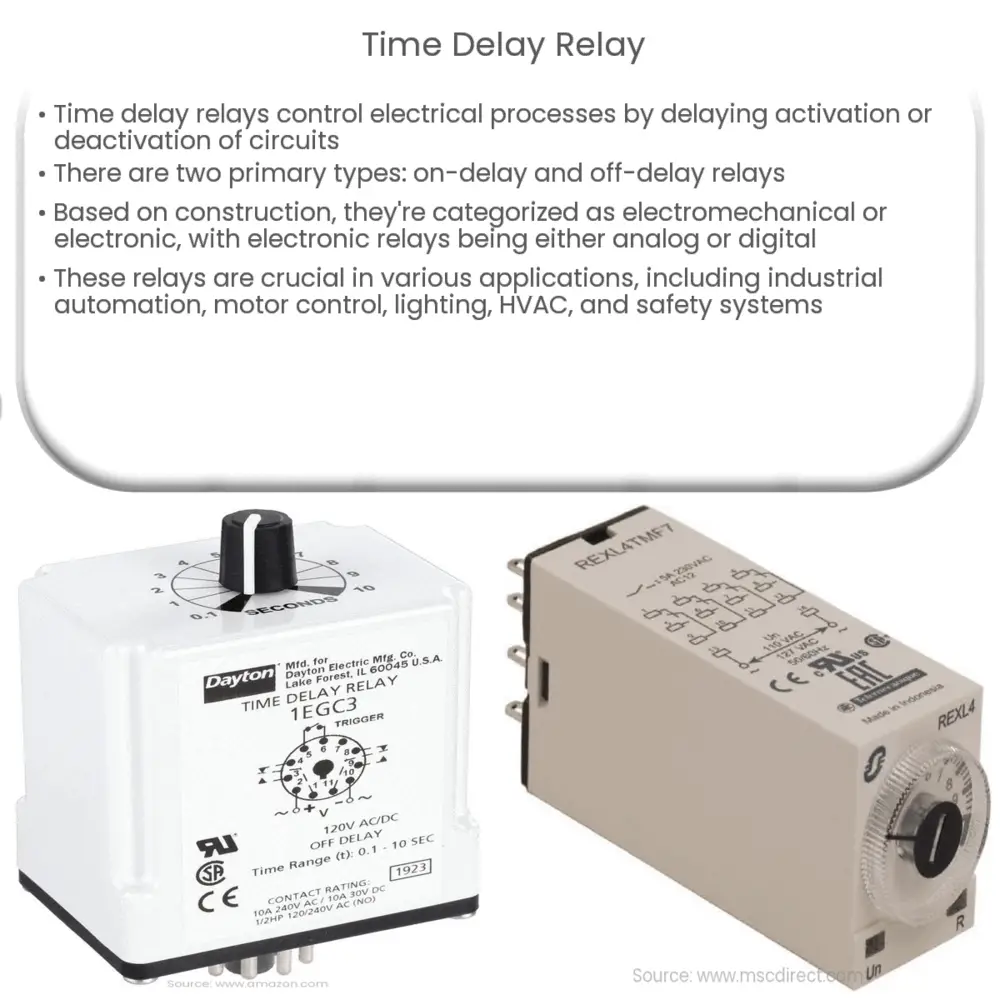A time delay relay is an electrical component that controls the activation or deactivation of a connected load after a set time interval.

Understanding Time Delay Relays: A Comprehensive Guide
Introduction
Time delay relays are versatile electrical components that enable control over the timing of various processes. They have become essential in a variety of applications, from industrial machinery to home appliances. This article will provide an in-depth understanding of time delay relays, their types, how they work, and their numerous applications.
What is a Time Delay Relay?
A time delay relay is an electromechanical or electronic device designed to switch a connected electrical load on or off after a specific time interval. These relays are used to delay the activation or deactivation of a circuit, giving the connected devices time to respond or complete a process. Time delay relays are invaluable for managing electrical systems, improving safety, and ensuring the smooth operation of equipment.
Types of Time Delay Relays
There are two main categories of time delay relays: on-delay and off-delay relays. Both types can be further classified as electromechanical or electronic time delay relays.
1. On-delay Time Delay Relays
On-delay relays, also known as delay-on-make or delay-on-operate relays, activate the connected load after a predetermined time interval when the control input is energized. The time delay starts when power is applied, and the load is switched on only after the delay time has elapsed.
2. Off-delay Time Delay Relays
Off-delay relays, also called delay-on-break or delay-on-release relays, maintain the connected load in an activated state until the control input is de-energized. Once the control input is de-energized, the relay initiates a predetermined time delay before switching the load off.
Electromechanical vs. Electronic Time Delay Relays
Time delay relays can be broadly classified into two types based on their construction and working principle: electromechanical and electronic time delay relays.
1. Electromechanical Time Delay Relays
Electromechanical time delay relays use mechanical components such as motors, gears, and switches to control the timing function. The most common types of electromechanical time delay relays are pneumatic, dashpot, and motor-driven relays. These relays are generally more affordable and easier to maintain, but they may not offer the same level of precision and flexibility as electronic time delay relays.
2. Electronic Time Delay Relays
Electronic time delay relays utilize solid-state components such as capacitors, resistors, and integrated circuits to manage the timing function. These relays offer greater accuracy, repeatability, and customization options compared to their electromechanical counterparts. Electronic time delay relays can be further divided into two categories: analog and digital time delay relays.
Analog vs. Digital Time Delay Relays
Electronic time delay relays can be either analog or digital, depending on their internal circuitry and components.
1. Analog Time Delay Relays
Analog time delay relays use analog components such as resistors, capacitors, and diodes to create time delays. The delay time is typically determined by the charging and discharging time of capacitors in the circuit. Analog time delay relays are generally simpler and more affordable compared to digital time delay relays, but they may not offer the same precision and customization capabilities.
2. Digital Time Delay Relays
Digital time delay relays employ microprocessors or microcontrollers to generate and control time delays. These relays provide superior accuracy, flexibility, and programmability, enabling users to adjust the time delay settings and functions easily. However, digital time delay relays are typically more expensive and may require specialized programming knowledge for customization.
Applications of Time Delay Relays
Time delay relays are employed in a wide range of applications across various industries, thanks to their versatility and usefulness in controlling processes and equipment. Some common applications include:
- Industrial automation: Time delay relays are used in automated production lines, conveyor systems, and assembly machines to control the timing of various processes and sequences.
- Motor control: In motor-driven equipment, time delay relays can provide a soft-start function or prevent rapid cycling, extending the motor’s life and reducing wear and tear.
- Lighting control: Time delay relays can be used to control the activation and deactivation of lighting systems in commercial and residential settings, ensuring energy efficiency and convenience.
- Heating, ventilation, and air conditioning (HVAC): Time delay relays are employed in HVAC systems to control the timing of fans, compressors, and other components, optimizing energy consumption and system performance.
- Safety and security: Time delay relays can be used in alarm systems, access control, and emergency equipment to ensure proper timing of critical functions and responses.
Conclusion
Time delay relays play a crucial role in controlling and managing various electrical processes and equipment. Their ability to provide precise, customizable timing functions makes them an invaluable tool in a wide range of applications, from industrial automation to home appliances. Understanding the different types of time delay relays and their specific features can help users select the most suitable relay for their specific needs, ensuring optimal performance and reliability.

